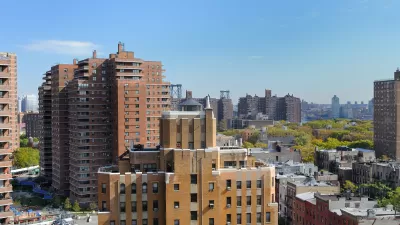The relatively low cost of holding on to vacant lots leads to underdevelopment in what are often prime residential areas.

An article by Konrad Putzier in the Wall Street Journal explains how the property tax system that keeps the cost of holding vacant land low contributes to the housing shortage plaguing most U.S. cities.
Putzier begins with the example of a vacant New York City lot, zoned for 1,500 apartments, that has sat empty for 17 years, with the owner paying minimal property taxes on the land. Across New York City, private vacant lots bigger than 3,000 square feet could yield around 858 million square feet of new housing and commercial space.
The article argues that low taxes on land and high taxes on buildings encourage property owners to hold vacant lots without developing on them, waiting for land values to rise. In regions like the Sun Belt, “The cost of inaction is usually low, particularly in suburban locations, where keeping a few cows on a lot allows landowners to qualify for massive property-tax breaks meant for ranchers.”
Proposals in Detroit, Philadelphia, and Richmond would reform those cities’ property tax systems to raise the tax on vacant lots and encourage developers to build. “Pittsburgh had a split-rate tax until 2001, and a number of studies found that it had more building activity than other Pennsylvania cities.”
FULL STORY: Housing Shortage Reflects the Cheap Cost of Holding Vacant Land

Alabama: Trump Terminates Settlements for Black Communities Harmed By Raw Sewage
Trump deemed the landmark civil rights agreement “illegal DEI and environmental justice policy.”

Study: Maui’s Plan to Convert Vacation Rentals to Long-Term Housing Could Cause Nearly $1 Billion Economic Loss
The plan would reduce visitor accommodation by 25% resulting in 1,900 jobs lost.

Why Should We Subsidize Public Transportation?
Many public transit agencies face financial stress due to rising costs, declining fare revenue, and declining subsidies. Transit advocates must provide a strong business case for increasing public transit funding.

Wind Energy on the Rise Despite Federal Policy Reversal
The Trump administration is revoking federal support for renewable energy, but demand for new projects continues unabated.

Passengers Flock to Caltrain After Electrification
The new electric trains are running faster and more reliably, leading to strong ridership growth on the Bay Area rail system.

Texas Churches Rally Behind ‘Yes in God’s Back Yard’ Legislation
Religious leaders want the state to reduce zoning regulations to streamline leasing church-owned land to housing developers.
Urban Design for Planners 1: Software Tools
This six-course series explores essential urban design concepts using open source software and equips planners with the tools they need to participate fully in the urban design process.
Planning for Universal Design
Learn the tools for implementing Universal Design in planning regulations.
Caltrans
Smith Gee Studio
Institute for Housing and Urban Development Studies (IHS)
City of Grandview
Harvard GSD Executive Education
Toledo-Lucas County Plan Commissions
Salt Lake City
NYU Wagner Graduate School of Public Service





























